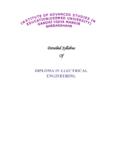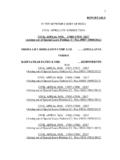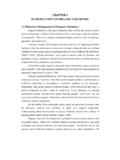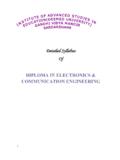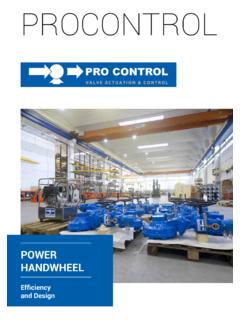Transcription of DIPLOMA IN CIVIL ENGINEERING - ::IASE Deemed University::
1 Detailed Syllabus of DIPLOMA IN CIVIL ENGINEERING . 1. DIPLOMA IN CIVIL ENGINEERING COURSE PERIOD: 3 YEARS (SIX SEMESTER) TOTAL MARKS 3000 FIRST SEMESTER COURSE TITLE PAPER CODE MARKS THEORY PRACTICAL TOTAL APPLIED MATHEMATICS I DCE 110 100 00 100 APPLIED PHYSICS DCE 120 50 50 100 DCE 120P APPLIED CHEMISTRY DCE 130 50 50 100 DCE 130P INTRODUCTION OF IT DCE 140 100 00 100 SECOND SEMESTER COURSE TITLE PAPER CODE MARKS THEORY PRACTICAL TOTAL COMMUNICATION DCE 210 50 50 100 SKILLS I DCE 210P APPLIED MATHEMATICS DCE 220 100 00 100 II APPLIED PHYSICE II DCE 230 50 50 100 DCE 230P ENGINEERING DRAWING DCE 240 50 50 100 DCS 240P WORKSHOP PRACTICE II DCS 250P 00 100 100 THIRD SEMESTER COURSE TITLE
2 PAPER CODE MARKS THEORY PRACTICAL TOTAL COMPUTER APPLICATION I DCE 310 50 50 100 DCE 310P APPLIED MACHINES DCE 320 50 50 100 DCE 320P CONSTRUCTION DCE 330 50 50 100 MATERIALS DCE 330P BUILDING CONSTRUCTION DCE 340 100 00 100 HYDRAULICS DCE 350 50 50 100 DCE 350P FOURTH SEMESTER COURSE TITLE PAPER CODE MARKS THEORY PRACTICAL TOTAL CIVIL ENGINEERING DCE 410 00 100 100 DRAWING I CONCREATE DCE 420 50 50 100. 2 TECHNOLOGY DCE 420P STRUCTURAL MACHINES DCE 430 50 50 100 DCE 430P SURVEYING I DCE 440 50 50 100 DCE 440P IRRIGATION DCE 450P 00 100 100 ENGINEERING FIFTH SEMESTER COURSE TITLE PAPER CODE MARKS THEORY PRACTICAL TOTAL CIVIL ENGINEERING DCE 510P 00 100 100 DRWAING II ELEMENTS OF RCC DCE 520P 00 100 100 DESIGN TRANSPORATION DCE 530 100 00 100 ENGINEERING SOIL & FOUNDATION DCE 540 50 50 100 ENGINEERING DCE 540P SURVEYING II CAMP DCE 550 50 50 100 DCE 550P SIXTH SEMESTER COURSE TITLE PAPER CODE MARKS THEORY PRACTICAL TOTAL EARTH QUAKE DCE 610 100 00 100 RESISTANT BUILDING
3 DCE 610P CONSTRUCTION ELEMENTS OF STEEL DCE 620 100 00 100 STRUCTURAL DESIGN ESTIMATION & COSTING DCE 630 100 00 100 CIVIL ENGINEERING DCE 640 50 50 100 DRAWING DCE 640P PROJECT WORK DCE 650P 00 200 200 Note: Theory Paper: 30% Continuous Internal Assessment and 70 % University examination. Practical Paper: 30 % Continuous Internal Assessment and 70 % University examination. Continuous Internal Assessment: 1) Two or three tests out of which minimum 60% of Continuous Internal Two will be considered for Assessment Assessment 2) Seminars/Assignments/Quizzes 30% of Continuous Internal Assessment 3) Attendance, class participation 10% of Continuous Internal Assessment And behavior 3 SEMESTER I DCE 110 APPLIED MATHEMATICS 1 Maximum Time : 3 Hrs.
4 University Examination :70 Marks Total Marks : 100 Continuous Internal Assessment : 30 Marks Minimum Pass Marks :40% A) Instructions for paper setter 1. The question paper will consist five sections namely A, B, C, D and E. 2. Each of the sections A, B, C and D will contain two questions and candidates have to attempt at least one question compulsorily from each section. Each section carry 15% of the total marks 3. Section E will com prise of 10 15 short answers type questions, which will cover the entire syllabus and will carry 40% of the total marks. B) Instructions for candidates 1.
5 Candidates are required to attempt one question each from sections A, B, C and D of the question paper and the entire section E. 2. Use of non programmable scientific calculator is allowed. SECTION A 1. AlGEBRA Application of Quadratic equations simultaneous equations (one linear and other Quadratic equation) in two variables to ENGINEERING problems. Arthmetic Progression, its nth term and sum of n terms with their applications to ENGINEERING problems. Geometrical Progression, its nth term and sum of n terms and to infinity with application to ENGINEERING problems. Partial fractions (excluding repeated quadratic factors) formally introduction of permutations & combinations, applications of formulae for npr ncr Binomial theorem (expansion without proof) for positive integral index (expansion and general term).
6 Binomial theorem for any index (expansion without proof only). First and second binomial approximation with application to ENGINEERING problems. SECTION B 2. TRIGNOMETRY Concept of angles, measurement of angles in degrees, grades and radians and their conversions. Trignometrical ratios and their relations. Review of ratios of some standard angles (0,30,45,60,90 degrees), T Ratios of Allied angles (without proof ), Sum, difference formulae and their applications (without proof). Product formulae (Transformation of product to sum, difference and vice versa).T Ratios of multiple angles, sub multiple angles (2A, 3A, A/2).
7 4 Area of a triangle, Hero's formulae, solution of triangles with direct applications of cosine formulae, sine formulae, Napier's analogy only. SECTION C 3. CO ORDINATE GEOMETRY Cartesian coordinates (two dimensions), Distance between two points, Internal and External division formulae, Application of area formulae (without proof). Area of triangle when its vertices are given, coordinates of centroid, incentre of a triangle when the vertices are given, using the formulaes, simple problems on locus. Application of equation of straight line in various standard forms, intersection of two straight lines, angle between two lines.
8 Perpendicular distance formulae. General equation of a circle and its characteristics. To find the equation of a circle given (i) Center and radius (ii) Three points on it (iii) Co ordinates of end points of a diameter. SECTION D Plotting of curves y = (f(x), f(x) being algebraic function of x (maximum upto 2 nd degree). Definition of conic section. Standard equation of parabola, To find equations of parabola when its focus and directrix are given, Given the equation of a parabola, determination of its focus, vertex axis, directrix and lactus rectum. Ellipse and hyberbola (standard equations without proof), given the equation in the standard form , determination of focus , directrix , lactus rectum.)
9 Axes, eccentricity and center. Concept of Polar coordinates & their conversion to Cartesian coordinates & vice versa, cylinder,cone,3D DCE 120 APPLIED PHYSICS I Maximum Time : 3 Hrs. University Examination : 35 Marks Total Marks : 50 Continuous Internal Assessment : 15 Marks Minimum Pass Marks : 40% A) Instructions for paper setter 1. The question paper will consist five sections namely A, B, C, D and E. 2. Each of the sections A, B, C and D will contain two questions and candidates have to attempt at least one question compulsorily from each section. Each section carry 15% of the total marks 3.
10 Section E will comprise of 10 15 short answers type questions, which will cover the entire syllabus and will carry 40% of the total marks. B) Instructions for candidates 1. Candidates are required to attempt one question each from sections A, B, C and D of the question paper and the entire section E. 2. Use of non programmable scientific calculator is allowed 5 SECTION A MECHANICS 1. UNITS AND DIMENSIONS Fundamental and derived units in SI System, Dimensions of Physical Quantitites, Principle of homogeneity Dimensional equation, Applications of dimensional analysis: Checking the correctness of physical equations, Derivation of simple physical relations, Limitation of Dimensional Analysis, significant figures and Error Analysis.
